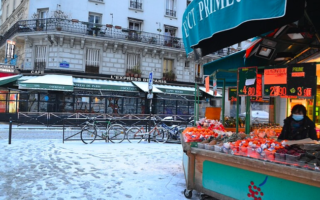Chaillot

- SUBSCRIBE
- ALREADY SUBSCRIBED?
BECOME A BONJOUR PARIS MEMBER
Gain full access to our collection of over 5,000 articles and bring the City of Light into your life. Just 60 USD per year.
Find out why you should become a member here.
Sign in
Fill in your credentials below.
 In a city made famous for its Old World charm and vestiges of the past, whose visitors are looking for the 19th century monuments and early 20th century tastes, one might forget that Paris is a place that also embraces the modern and the refreshing. One place that pays homage to the past while facing towards the future is the Théâtre National de Chaillot.
In a city made famous for its Old World charm and vestiges of the past, whose visitors are looking for the 19th century monuments and early 20th century tastes, one might forget that Paris is a place that also embraces the modern and the refreshing. One place that pays homage to the past while facing towards the future is the Théâtre National de Chaillot.
 The Palais de Chaillot was first built in 1878 but the theater as we know it today wasn’t completed until 1937. Nowadays, most of the performances that take up their short-lived residencies in these marbled halls are of the modern dance variety, performances that are so modern that they make you question your artistic sensibilities. However, the contemporary atmosphere of the theater is immediately challenged as you walk up the marble steps and under the high-arching ceilings. The walls are smooth and white using minimalistic and clean lines; suddenly, you warped into the thirties. The vestiges of the Lost Generation and their definitive art deco are all around you; all you need is a flapper dress and long cigarette. A simultaneously unpretentious yet majestic staircase leads you down to the wide and open theater, richly draped in that characteristic maroon. The architecture itself is worth seeing at Chaillot, but it is what is being performed in the theater itself that brings this memory of the past into the present.
The Palais de Chaillot was first built in 1878 but the theater as we know it today wasn’t completed until 1937. Nowadays, most of the performances that take up their short-lived residencies in these marbled halls are of the modern dance variety, performances that are so modern that they make you question your artistic sensibilities. However, the contemporary atmosphere of the theater is immediately challenged as you walk up the marble steps and under the high-arching ceilings. The walls are smooth and white using minimalistic and clean lines; suddenly, you warped into the thirties. The vestiges of the Lost Generation and their definitive art deco are all around you; all you need is a flapper dress and long cigarette. A simultaneously unpretentious yet majestic staircase leads you down to the wide and open theater, richly draped in that characteristic maroon. The architecture itself is worth seeing at Chaillot, but it is what is being performed in the theater itself that brings this memory of the past into the present.
 I’ve seen two shows at the Théâtre National de Chaillot, both modern dances. Both beautiful, both fantastic. However, Orphée, a modern dance that circled around the tragic story of Orpheus and Eurydice and their ill-fated love, is a show that refuses to be forgotten. Using this classic Greek myth as only a tentative starting point, the rest of the show was, to say the least, a high-energy explosion of creativity that shocked and awed. It was the best of both worlds: a mélange of past and present, classic and tribal, European and African, youth and maturity. There was a large digital screen at the back of the stage, heavily using modern video graphics to sync with the live performance. Digital sound effects melded with the sounds of 17th century. Rapping soon gives way to an up-in-the-rafters countertenor solo. A man on stilts dances with a man on crutches. Cellists and African chants provide the background to breakdancing. The incredible mish-mash of the elements as well as its classical themes make for an unforgettable show that challenges every perception of what a classical spectacle should be.
I’ve seen two shows at the Théâtre National de Chaillot, both modern dances. Both beautiful, both fantastic. However, Orphée, a modern dance that circled around the tragic story of Orpheus and Eurydice and their ill-fated love, is a show that refuses to be forgotten. Using this classic Greek myth as only a tentative starting point, the rest of the show was, to say the least, a high-energy explosion of creativity that shocked and awed. It was the best of both worlds: a mélange of past and present, classic and tribal, European and African, youth and maturity. There was a large digital screen at the back of the stage, heavily using modern video graphics to sync with the live performance. Digital sound effects melded with the sounds of 17th century. Rapping soon gives way to an up-in-the-rafters countertenor solo. A man on stilts dances with a man on crutches. Cellists and African chants provide the background to breakdancing. The incredible mish-mash of the elements as well as its classical themes make for an unforgettable show that challenges every perception of what a classical spectacle should be.
And as a theater that looked towards the modern while still reaching back to the past, there couldn’t be a better venue for Orphée than the Théâtre National de Chaillot.
Clearly, if you’re looking for a sneak peek into the modern performance scene in Paris, Chaillot is the place to go. It’s a place where you can find the contemporary without squishing yourself into a tiny back room; all of the beauty in Paris is stretched out before you at Chaillot. And if you’re lucky enough to walk into the foyer of the theater at just the right time at night, the salon lights might obligingly dim to treat you to a perfect view of the Eiffel Tower and its falling stars.
The Théâtre National de Chaillot is easily reached by taking the metro (Lines 9 or 6) or by bus (Numbers 22, 30, 32, 63, 72, or 82). The theater is only open to visitors during show nights.
Future shows: La Jeune Fille et la Mort (March 15-21), Mirror and Music (March 29-31), Au-delà (April 4-7), Le Sacre de Printemps (April 6-13), Lalala Gerswin (May 2-19), Swan (June 6-14)
More in architecture, French architecture, theater


